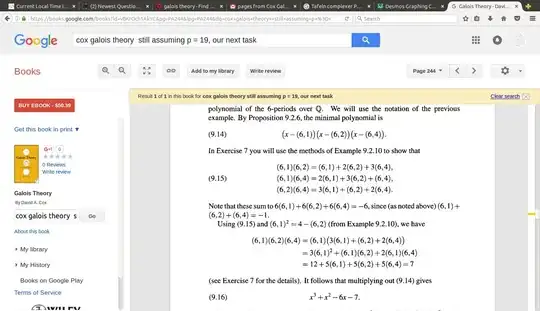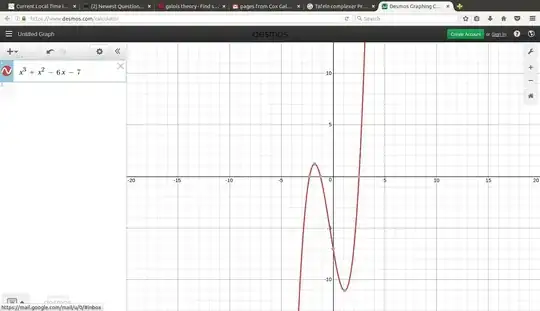I guess Jyrki wanted me to post something here. Gauss initiated a study of cyclotomic fields in the Disquisitiones. I found a modern treatment in chapter 9 of Galois Theory by David A. Cox.
If we begin with your polynomial $g(x) = x^3 + 2 x^2 -5x +1 ,$ then we take
$$ f(x) = - g(-x-1) = x^3 + x^2 - 6x - 7. $$ This example is given on page 26 of Reuschle and page 244 of Cox. Given a 19th root of unity $\alpha,$ the three roots, which are real, are expressed as sums of powers of $\alpha.$ Furthermore, these are always paired as a root plus its reciprocal, resulting in cosines.
$$ \eta_0 = 2 \cos \left( \frac{2 \pi}{19} \right) + 2 \cos \left( \frac{14 \pi}{19} \right) + 2 \cos \left( \frac{16 \pi}{19} \right) \approx 2.5070 $$
$$ \eta_1 = 2 \cos \left( \frac{4 \pi}{19} \right) + 2 \cos \left( \frac{6 \pi}{19} \right) + 2 \cos \left( \frac{10 \pi}{19} \right) \approx -2.2851 $$
$$ \eta_2 = 2 \cos \left( \frac{8 \pi}{19} \right) + 2 \cos \left( \frac{12 \pi}{19} \right) + 2 \cos \left( \frac{18 \pi}{19} \right) \approx -1.221 $$
Note that Reuschle provides some multiplications,
$$\eta_0^2 = 4 - \eta_1, \; \; \eta_0 \eta_1 = -1 + \eta_1 + 2 \eta_2, \; \; \eta_0 \eta_2 = -1 + \eta_0 + 2 \eta_1 $$
Getting there:
$$ \eta_1 \eta_2 = -4 - \eta_0 -3 \eta_1 - 2 \eta_2, $$
$$\eta_1^2 = 4 - \eta_2,$$
$$ \eta_2^2 = \frac{1}{2} \left( 11 + \eta_0 + 3 \eta_1 + 3 \eta_2 \right). $$
Symmetric things
$$ \eta_0 + \eta_1 + \eta_2 = -1, $$
$$ \eta_1 \eta_2 + \eta_2 \eta_0 + \eta_0 \eta_1 = -6, $$
$$ \eta_0 \eta_1 \eta_2 = 7, $$
$$ \eta_0^2 + \eta_1^2 + \eta_2^2 = 13, $$
$$ \eta_0^3 + \eta_1^3 + \eta_2^3 = 2. $$



I can emphasize how very straightforward it is to prove the roots work, when given in this fashion. In the following, just use the relation $t^{19} = t^{38} = 1$ to arrive at
$$ 11(t^{18} + t^{17} +t^{16} +t^{15} +t^{14} +t^{13} +t^{12} +t^{11} +t^{10} +t^9 +t^8 + t^7 + t^6 + t^5 + t^4 + t^3 + t^2 +t+1) $$
? x = t + t^7 + t^8 + (1/t) + ( 1/t^7) + ( 1/t^8)
%2 = (t^16 + t^15 + t^9 + t^7 + t + 1)/t^8
? p = x^3 + x^2 - 6 * x - 7
%3 = (t^48 + 3*t^47 + 3*t^46 + t^45 + 3*t^41 + 7*t^40 + 8*t^39 + 7*t^38 + 3*t^37 + 3*t^34 + 8*t^33 + 11*t^32 + 11*t^31 + 8*t^30 + 3*t^29 + t^27 + 7*t^26 + 11*t^25 + 11*t^24 + 11*t^23 + 7*t^22 + t^21 + 3*t^19 + 8*t^18 + 11*t^17 + 11*t^16 + 8*t^15 + 3*t^14 + 3*t^11 + 7*t^10 + 8*t^9 + 7*t^8 + 3*t^7 + t^3 + 3*t^2 + 3*t + 1)/t^24
? q = p * t^24
%4 =
t^48 + 3*t^47 + 3*t^46 + t^45 + 3*t^41 + 7*t^40 + 8*t^39 +
7*t^38 + 3*t^37 + 3*t^34 + 8*t^33 + 11*t^32 + 11*t^31 + 8*t^30 + 3*t^29 +
t^27 + 7*t^26 + 11*t^25 + 11*t^24 + 11*t^23 + 7*t^22 + t^21 + 3*t^19 +
8*t^18 + 11*t^17 + 11*t^16 + 8*t^15 + 3*t^14 + 3*t^11 + 7*t^10 +
8*t^9 + 7*t^8 + 3*t^7 + t^3 + 3*t^2 + 3*t + 1
?


